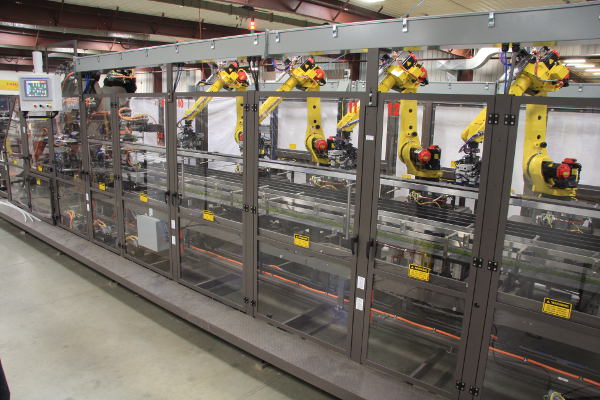“Tottle” is an industry word for a type of bottle that can sit on the cap end. Examples of this include ketchup or shampoo. While a “bottle” sits on its “bottom” and has a cap at the top, a “tottle” sits on its “top,” which is also the cap.
Tottles present a packaging challenge, because in order for a tottle to be filled and capped, the cap-side of the bottle must be upright (opposite of how it sits on store and consumer shelves). The other end of the tottle is typically rounded, creating instability and preventing the tottle from remaining upright unassisted. The solution to filling, capping and case packing a tottle is to insert the rounded end of the tottle into a “puck”. The tottle remains securely contained in the same puck throughout the entire packaging process.
In this video a system is comprised of a traditional continuous motion case packer frame merged with four FANUC M-20iA robots. The traditional case packer frame performs case erecting, forming and sealing. It also has the benefit of securely handling the unstable tottle product through continuous motion to allow for smoother operation. The robots perform the packing function and provide the benefit of reaching very high speeds and quick changeover. This case packing solution reaches a maximum rate of 320 pucks per minute.
 The four FANUC M-20iA robots pick tottles from the inbound pucks and place them into the moving cases. Each of the FANUC M-20iA robots attend to a fixed area of the puck and case conveyors. Each robot controls the expansion of a specified product tool that is unique to the product type. The robot’s end-of-arm-tool adjusts to pick bottled product from a pre-positioned matrix of pucks, then collapses the end-of-arm-tooling to form the smaller matrix size necessary for insertion of the product into pre-positioned cases.
The four FANUC M-20iA robots pick tottles from the inbound pucks and place them into the moving cases. Each of the FANUC M-20iA robots attend to a fixed area of the puck and case conveyors. Each robot controls the expansion of a specified product tool that is unique to the product type. The robot’s end-of-arm-tool adjusts to pick bottled product from a pre-positioned matrix of pucks, then collapses the end-of-arm-tooling to form the smaller matrix size necessary for insertion of the product into pre-positioned cases.
The robots use individual “line tracking” control to accurately follow the motion of the pucks and the opened trays/cases during loading. This ensures the bottles are accurately positioned in the trays/cases and allows the tray/case transport to be continuous motion. Each robot is equipped with a coupling device (EOAT changer) that is software controlled and allows the robot to automatically switch to an alternate EOAT when a command signal is issued. This allows the automatic changeover process to be initiated by a signal from the case packer PLC.
 Each robot utilizes FANUC’s Collision Guard option for collision detection rather than mechanical clutch mechanism. Additionally, FANUC PickPro Software designates pick assignments for the robot. This option allows a single robot or multiple robots to be taken out of service while allowing the remaining robots to run at a reduced throughput.
Each robot utilizes FANUC’s Collision Guard option for collision detection rather than mechanical clutch mechanism. Additionally, FANUC PickPro Software designates pick assignments for the robot. This option allows a single robot or multiple robots to be taken out of service while allowing the remaining robots to run at a reduced throughput.
The combined loading processes of the four robots provides a product throughput of up to 320 bottles per minute and a packed case rate of up to 80 cases per minute.

